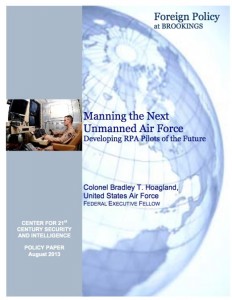As a nation, we are in the middle of discussions and debates regarding the current and future use of unmanned systems. Whether it’s the ethical or legal debates regarding “drone” strikes in the Middle East and Northern Africa, or the safety, security and privacy concerns with the use of domestic drones (or unmanned systems) in the Federal Aviation Administration (FAA) airspace, the debate will continue.
However, leading UAS experts inside and outside of government all agree that they are here to stay, and the proliferation of these systems will continue to explode over the next decade.
But in order for the U.S. Air Force to stay innovative and relevant in the furtherance of unparalleled Remotely Piloted Aircraft (RPA) operations, it must immediately take a new approach and reevaluate the personnel programmes that most effectively contribute to this vital mission. A robust RPA community begins with a more deliberate accessions process and carries through to a continuum of education and training opportunities later in an officer’s career. The Air Force cannot wait another decade to ensure the RPA community gets professionally developed, recognized, and promoted on par with other officers in the Air Force.
The recommendations presented here are pragmatic changes that should be implemented to more effectively identify and develop future RPA pilots. They are based on the range of education and learning from day one taking place at the various commissioning sources all the way until promotion into the senior leadership ranks within the Air Force. The sooner the Air Force fully integrates these aviators into its professional developmental plans, the more effective the RPA community will be in recruiting, training, and retaining high potential officers.
To download the paper, click here.
Source: Brookings Press Release

